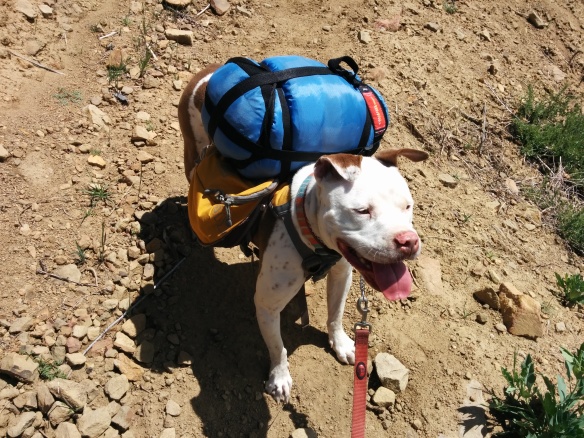When we first started backpacking with Dakota, we had a lot of questions about gear. Does she need a pack? How about boots? Jackets? Suffice to say, Dakota is probably has enough gear to rival her human counterparts. The biggest question was about her sleep system. While some dogs have thick coats and are suited for cold weather, Dakota’s short coat does not retain enough heat to keep her warm.
While on one of our trips, the weather turned from a 75 degree day, to dipping in the low 30s at night. Dakota was freezing. Her Rough Wear jacket (photo below) and bed were not keeping her warm enough, instead, she forced her way into our quilts and huddled close to our bodies.

To decide on the best sleep system, we looked at several factors:
1. Weight – It needs to be light enough to keep her pack weight low, and keep her mobile
2. Size – A small form factor matters. Dogs need to be nimble enough to navigate through technical terrain.
3. Warmth – Why else would you buy a sleep system?
We found three options that worked best were, but not all satisfied the requirements.
A thick coat
We bought a cheap and thick dog coat at our local pet supply store for about $20. The coat keeps Dakota warm at night and has holes for her legs to pop through. The problem we found is that it is bulky, heavy, and not designed to be used for backcountry camping. Dakota could not carry the coat on her own, and it added a good pound and a half to our pack weight.
An old sleeping bag
 We had an old Suisse Sport sleeping bag in our gear closet with a broken zipper. Originally, we were planning to cut the bag up and use it as a quilt system. Instead, we used it as a full sleep system for Dakota. Bottom folded up into a bed, and the top wrapped around her body, keeping her warm in cold weather. At two pounds, it was relatively lightweight, Dakota could carry it with ease and this increases her cuteness factor by at least 10 fold. However, it didn’t stay on her very well, and when she moved around at night, we would have to get up to fix the bag so she would stay warm.
We had an old Suisse Sport sleeping bag in our gear closet with a broken zipper. Originally, we were planning to cut the bag up and use it as a quilt system. Instead, we used it as a full sleep system for Dakota. Bottom folded up into a bed, and the top wrapped around her body, keeping her warm in cold weather. At two pounds, it was relatively lightweight, Dakota could carry it with ease and this increases her cuteness factor by at least 10 fold. However, it didn’t stay on her very well, and when she moved around at night, we would have to get up to fix the bag so she would stay warm.
A child size quilt
 By far the best solution was a child size quilt with snaps on the back. We purchased a used Enlightened Equipment Protege quilt. The Protege quilt was designed as a child’s size quilt, but is perfectly suited for a dog her size. The snaps allow Dakota to walk around freely with the quilt on in the morning, move around the tent as she pleases, and stays securely strapped to her.
By far the best solution was a child size quilt with snaps on the back. We purchased a used Enlightened Equipment Protege quilt. The Protege quilt was designed as a child’s size quilt, but is perfectly suited for a dog her size. The snaps allow Dakota to walk around freely with the quilt on in the morning, move around the tent as she pleases, and stays securely strapped to her.
We’d love to hear what are some ways you keep your dogs warm during backpacking trips!





 By far the best solution was a child size quilt with snaps on the back. We purchased a used Enlightened Equipment Protege quilt. The Protege quilt was designed as a child’s size quilt, but is perfectly suited for a dog her size. The snaps allow Dakota to walk around freely with the quilt on in the morning, move around the tent as she pleases, and stays securely strapped to her.
By far the best solution was a child size quilt with snaps on the back. We purchased a used Enlightened Equipment Protege quilt. The Protege quilt was designed as a child’s size quilt, but is perfectly suited for a dog her size. The snaps allow Dakota to walk around freely with the quilt on in the morning, move around the tent as she pleases, and stays securely strapped to her.

